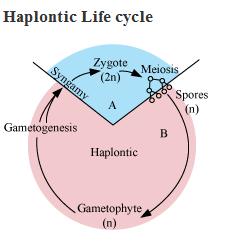explain haplontic and diplontic life cycle? [biology chapter 1 lesson 4 post fertilisation events]
In this type of life cycle haploid phase of the cells is predominant. The zygotic meiosis produces haploid spores. These haplonts will then divide mitotically to produce more haplonts. These haplonts will give rise to male and female gametes. In haplontic life cycle 2n state of nuclei is present only in the zygote and this state is very short lived. The organism ends its diploid phase and produces several haploid cells. These cells divide mitotically to form either larger, multicellular individuals, or more haploid cells. Two opposite types of gametes (e.g., male and female) from these individuals or cells fuse to become a zygote. Main vegetative plant body is haploid. Example - fungi, green algae and many protozoa.

In diplontic life cycle the diploid sporophyte is the dominant photosynthetic independent phase of plant body. The haploid phase is represented by gametes only. In gametic meiosis, instead of immediately dividing meiotically to produce haploid cells, the zygote divides mitotically to produce a multicellular diploid individual. Cells from the diploid individuals then undergo meiosis to produce haploid cells or gametes. Haploid cells may divide again (by mitosis) to form more haploid cells, as in many yeasts, but the haploid phase is not the predominant life cycle phase. In most diplonts, mitosis occurs only in the diploid phase, i.e. gametes usually form quickly and fuse to produce diploid zygotes. Main plant body is diploid (sporophyte 2n). Example − All seed-bearing plants, gymnosperms, and angiosperms.


